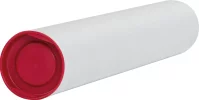Whichever pack you choose it should be large enough to include everything being able to fit INSIDE of the bag. No dangling stuff outside of the pack because there isn't enough room. Dangly bits hanging from a pack, like extra shoes, bags of groceries, etc, can make the pack shift around more, catch branches and bushes, throw off the center of gravity, and make the pack less comfortable.
Temporary placement of drying garments are understandable; some gear that is lashed to the pack, like a sleeping bag or pad, has been designed into some packs ... these are not what I am referring to.

However, if what should normally be
inside of the pack needs to be clumped onto the outside because the pack is too small, then there is no purpose and rationale for having a smaller pack.
As has been said before, gather all of the items for your Camino ... all of them down to the teeniest item. Put anything you plan on inserting into stuff sacks actually into those stuff sacks. Include all ancillary items, like a bag of pretend snacks, water bottles, guides, maps, electronics, etc.
Now, after you are sure you have EVERYTHING, fit it into the pack. I never have a pack so full that I have to jam everything into the bag with force, or have anything bulging up out of the top of the pack so that I have to really pull on the straps fastening down the lid of the pack. All zippers should be easy to pull open and shut.
Can't do that? I then prefer a bigger volume of pack. Keep in mind that the usability of the pack isn't only how it carries, but how easy it is to get to things inside and to unpack and re-pack. After all, you will need to get into your 'house' several times every day, at least. And you will need to re pack everything again. Day after day for a few weeks. I want to be able to get into my 'house' fairly easy. And I also know that the longer one lives out of a pack, the smaller it seems to get as you spend less time wanting to organize the heck out of stuff just to make it fit.
There can be a real concern that the inexperienced will not have the wisdom or experience to understand that extra space is not a challenge to add more stuff. That's why encouraging beginners to work from a packing list is important advice ---- nothing goes into the pack that isn't on the list. In other words, train to pack to the list, not to the space available in a pack.

My pack is about 65 liters with its extension collar up. For Camino, my gear and clothing takes up about half that volume. I don't look at that empty space and say to myself, "Oh, goody, now I have room for my crock pot".

But that's because of my experience, which is why it is important for the 'veterans' to pass on wisdom of the packing list and contents to the Camino newbies

Now, I can hear someone think, "Why doesn't he take a 35 or 40 liter pack and save more weight, instead of that 65 liter?" Three reasons:
1. My Gossamer Gear pack is lighter at just under two pounds, than most other smaller packs. My Osprey 32 liter pack that I use for my day hikes is nearly a pound and a half heavier.
2. My pack is well fitted to me and comfortable.
3. It meets all the dimension requirements for carry-on luggage for both domestic and international flights. I can pack it to carry 13 pounds of my gear used for month's long wilderness thru-hikes, or 8 pounds of gear for a Camino and I don't have to check it as baggage and risk losing it or waiting for its return. After having had my backpack and gear for a backpacking trip irrecoverably lost by an airline after arriving at my trail head destination, I will not check my back pack in again.
Plus as a carry on, I can get out of the airport quicker, or to a connecting flight faster.






















